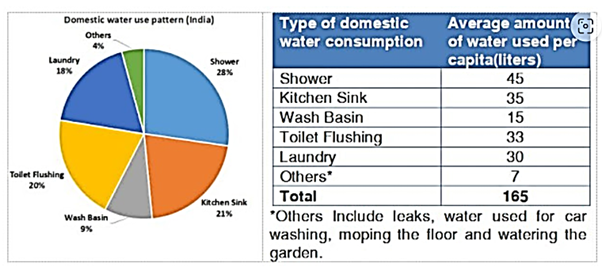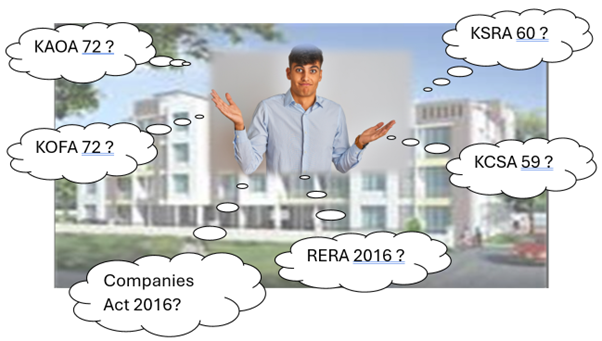How our communities can conserve up to 30 % of water that is routinely wasted!
- Our Water conservation team
- Jul 25, 2024
- 4 min read
Updated: May 1

We know the broad statistics – India is facing a water crisis, with a 75% decrease in yearly water availability per person from 1947 to 2021. We are dealing with a number of issues, including the disappearance of ponds, lakes, tanks, and wetlands, as well as the depletion of groundwater and the pollution of surface water. We have 18 percent of the world’s population, but only 4 percent of its water resources, making us among the most water-stressed in the world.
The World bank, Indian central and state governments and scores of NGOs are working round the clock to overcome this alarming situation through multiple projects in different sectors – from agricultural to urban lands. But the situation is still grim.
It is estimated that roughly 30% of water that is supplied to households and their surrounding environments can be conserved and a substantial amount directed to recharge groundwater. But for this to happen, communities must build awareness and collective resolve and employ practices and technology which they may not be familiar with. In this article we bring you universal information and specifics for the city of Bengaluru in an easy to read and understand format.
A good start is to understand where our supplied water goes in the average apartment. This chart from enviraj.com is one of the most illustrative and indicates that every person uses an average of 165 litres per day.

India’s premier TERI ( The Energy and Resources Institute) however recommends 135 litres per person per day as the benchmark for urban areas. So is the reduction of approximately 30 litre per person per day possible? It very much is, through these measures which are well within our capabilities.
By individual households
#1 Use low-flow shower heads for bathing. Collect initial cold water in a bucket while waiting for your hot water to arrive. Aim for the 2 minute Navy shower! Turn off the shower while soaping. Or use half a bucket of water with a small mug. Need frequent cleaning? Try sponging your dirty areas instead!
#2 Instead of a running tap, use a basin for washing dishes – The first for soaking plates, then soaping them and the second to rinse. Short spray a final rinse from your tap.
#3 Use the rejected water of your RO water purifier for the first step of dish washing above. You could also use it for the first rinse of vegetables /meat or mix it with fresh water for mopping/cleaning surfaces, car cleaning and watering plants.
#4 Use a tooth-glass for brushing teeth and shaving, instead of a running tap.
#5 Most toilet flushes work on dual modes – half and full tank. Avoid a full tank flush when possible.
#6 If you are supplied with recycled/treated gray water, use it for your toilets and plants.
#7 Water metering devices are getting cheaper and are available for approximately Rs 6000/- per inlet pipe with the possibility of combining two inlet pipes to one meter. Metering and charging for consumption can reduce it by a whopping 20 %!
#8 Instead of hosing down your car with water, you could wipe the outer surfaces regularly using a wet cloth, frequently rinsing it to remove the dirt. This leads to a tremendous 80% saving of water.
#9. Get your leaking taps repaired and keep a watch out for leaking flush tanks. You can check this by putting a little colouring agent ( like diluted blue Harpic cleaner liquid ) in the flush tank and checking to see if it leaks into the commode bowl.
#10. Mop your balconies instead of flushing them with water. Spot clean the dirty, more used parts of your floors and do a full mop once in a way.
#11. Choose a front load washing machine instead of a top load one which uses more water. Use full loads or a lower water level setting. Spot clean dirty parts of your clothes immediately and dont wash your clothes more than necessary. This preserves the fabric too.
By residential communities
#1 Use recycled/treated gray water for watering gardens. Employ sweeping for cleaning common areas with mopping/washing only in places where it is unavoidable.
#2 Harvest your rain-water. Roof top run-off can be mixed with fresh water supplied by pipelines/borewells/tankers for treatment in your plant. And ground run-off can be used for watering plants. This can also be routed to your treatment plant after de-silting and is useful in emergencies.
#3 In urban areas, concretised surfaces prevent rain from recharging groundwater. Your community ( along with neighbouring ones) can contribute by boring recharging wells. In Bangalore, this would cost approximately Rs 2 lacs per recharging well. Read more on how to here.
#4 If you are being supplied with water in tanker truck, fit flow meters to measure the water you are receiving in your underground sumps.
#5 Use water sprinklers/sprayers for lawns and gardens. You could also try drip irrigation especially when you are using fresh water and treated gray water is not available.
#6 Install a micro recycling/ treatment plant for your gray water ( from your kitchens and bathrooms) and use the treated water for toilet flushing and gardens.
#7 If you have surplus treated water, make arrangements to sell it to construction companies or donate it to municipal gardens. If you still have balance, you can direct the surplus into recharge wells, while ensuring the water quality is within your local regulations. Do not direct them into bore well sides since this water could contaminate underground aquifers.
#8 If you have multiple buildings in your apartment complex, you could monitor the supply to each and share the data on savings with members to motivate them.
Finally, remember to remind your community members periodically even when the water situation improves, because it takes many months after good rains for ground water to recharge. It may seem a drop in an ocean, for one community. But imagine the collective effect of 30,000 communities in Bengaluru!
We hope you found this article useful. Do write in to us at contact@cocreed.in if you have any questions or additional information/tips to share. We plan to keep our articles updated as best practices for the benefit of all our subscribers!



Very important topic and useful tips in a concise form!